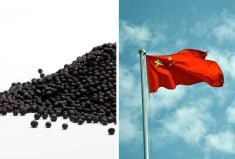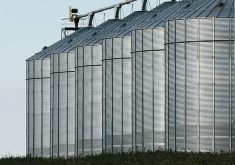VANCOUVER — North American farmers have used weed control methods for the past two decades that are comparable to eating at a fast food restaurant: convenient and cheap.
However, simplistic weed control had serious consequences, causing glyphosate resistance to spread across the continent.
The major chemical companies say the era of easy and cheap weed control is now officially over.
“It will never be that way again. That’s absolutely clear,” Bayer CropScience product development manger Arlene Cotie said during a panel discussion on herbicide resistance management at the Weed Science Society of America annual meeting held in Vancouver Feb. 3-6.
Read Also

Canada and China discuss disputes over canola and EVs, says Ottawa
Senior Canadian and Chinese officials discussed bilateral trade disputes involving canola and electric vehicles on Friday, Ottawa said, but gave no indication of any immediate breakthrough.
“It doesn’t matter who you listen to … Syngenta, Monsanto, Dow, there’s no silver bullet.”
The final morning of the four-day meeting was dedicated to discussing herbicide stewardship and how to convince growers to adopt integrated weed management, which includes high seeding rates, harvest weed seed control and diversified crop rotations.
Cotie, who lives in North Carolina but is still involved in the family farm in Saskatchewan, said integrated weed management isn’t an easy sell because it’s the opposite of convenient and cheap.
“Integrated weed management isn’t simple and they (growers) want simple,” she said.
“What is that silver bullet to get grower adoption? I don’t think any of us have figured that out.”
Respect the Rotation, an initiative developed by Bayer, encourages farmers to rotate crops, modes of action and herbicide tolerant traits.
The United Soybean Board in the United States has launched a similar program, Take Action, in partnership with university extension services and crop protection companies.
Cotie said these types of campaigns are essential to convincing growers to spend money and time on weed control.
“You’re going to have to invest up front for long-term return on investment,” she said.
“That’s what we really want to demonstrate with Respect the Rotation: what is that five-year plan? What does that look like?”
Damon Palmer, Dow AgroSciences’ U.S. commercial leader for the Enlist weed control system, said Dow and other crop protection companies have a financial interest in integrated weed management.
He estimated it costs $250 million to research and develop a new crop protection product. Farmers can help extend the life of herbicides and boosts the return on investment by using integrated weed management.
Neil Harker, an Agriculture Canada weed scientist in Lacombe, Alta., said this represents a philosophical shift for the crop science industry.
“What they had been doing is taking the best product and flogging it for as long as it would live,” he said in an interview during the conference.
“They’re (now) saying these … practices, no matter what they are… planting clean seed or harvest weed seed management, they’re going to (benefit) companies and retailers as well as growers, in the long term.”
Harker said the tricky part is persuading farmers to look beyond a single growing season.
“Until people are willing to say, ‘I’m looking at this as a multi-generational view and I’m going to do something here that’s going to help my children and grandchildren,’ you (have) very little incentive to make some short-term changes.”
Mark Peterson, Dow AgroSciences’ global biology team leader, said industry and extension personnel have to remember that farms have changed dramatically over the last 30 years. Producers now manage more acres with fewer people. They don’t have a lot of time to dedicate to weed management.
“We all understand that the days of super-easy, convenient weed control probably are behind us … (but) if we go flat out and say you’re going to have to do this, this, this and this, and spend 10 times as much time as you do today (on weed control) … you’re going to lose them right away.”
Cotie said programs that encourage farmers to adopt sustainable weed control might not suffice.
“There are 25 percent of those guys out there who are repeatedly abusing glufosinate. We can model that and know exactly where glufosinate is going to go, (it’s) going to go off the cliff also,” she said.
“Maybe there is a component in there of some mandate.”















